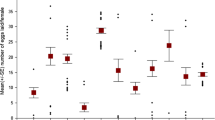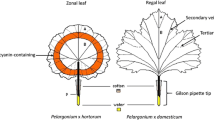Abstract
Survival ofAcanthoscelides obtectus larvae depends on the ability of the first instar to pierce the seed coat ofPhaseolus vulgaris, which represents a critical sequence because of physical characteristics and toxicity. We have investigated the influence of seed surface quality on larval boring behavior by the usual method of surface washing with different solvents, or by removing the testa, or by coating the testa with a polymer spray. Observations were made on isolated larvae in no-choice and dual-choice bioassays. In the no-choice situation, larval penetration was reduced after seed coats were soaked with chloroform, whereas water, diethyl ether, or methanol had no significant effect. The ratio of boring attempts to successful penetrations was increased on seeds washed with chloroform. In the dual-choice situation, larvae avoided artificially coated seeds and preferred untreated seeds over those washed with chloroform or methanol. These results indicate that boring stimulants exist on the seed coat and that they are removed by chloroform and methanol or made inaccessible by artificial coating. The high mortality of first instars on seeds washed with these two solvents is attributed to a lack of chemicals necessary to initiate and sustain boring behavior, causing larval stress, possibly due to prolonged locomotory activity and starvation. Thus, seed coat quality may influence the population dynamics ofA. obtectus.
Similar content being viewed by others
References
Bernays, E.A., Blaney, W.M., Chapman, R.F., andCook, A.G. 1976. The ability ofLocusta migratoria to perceive plant surface waxes.Symp. Biol. Hung. 16:35–40.
Cardona, C., Posso, C.E., Kornegay, J., Valor, J., andSerrano, M. 1989. Antibiosis effects of wild dry bean accessions on the mexican bean weevil and the bean weevil (Coloeptera: Bruchidae).J. Econ. Entomol. 82:310–345.
Janzen, D. 1977. How southern cowpea weevil larvae (Bruchidae:Callosobruchus maculatus) die on non-host seeds.Ecology 58:921–927.
Jarry, M. 1984. Histoire naturelle de la bruche du haricot dans un agrosystème du sud ouest de la france: Contribution à l'étude de la structure et de la dynamique des populations d'Acanthoscelides obtectus say dans les stocks et les cultures dePhaseolus vulgaris. Thèse d'état. Université de Pau, 181 pp.
Johnson, C.D. 1989. Adaptative radiation ofAcanthoscelides in seeds: Examples of legume-bruchid interactions.Monogr. Syst. Bot. Mo. Bot. Gard. 29:747–779.
Labeyrie, V. 1961. Obtention d'une souche “astime” chezAcanthoscelides obtectus Say.C.R. Soc. Biol. Paris 155:1366–1369.
Leroi, B., andJarry M. 1981. Relations d'Acanthoscelides obtectus Say (Coléptères Bruchidae) avec différentes espèces dePhaseolus: Influence sur la fécondité et les possibilités de développement larvaire.Entomol. Exp. Appl. 30:73–82.
Pouzat, J. 1970. Rôle des organes sensoriels céphaliques dans l'ovogénèse et l'emission chez la bruche du haricotAcanthoscelides obtectus Say.Colloq. Int. CNRS 189:381–400.
Pouzat, J. 1976. Le comportement de ponte de la bruche du haricot en présence d'extraits de plante hôte. Mise en évidence d'interactions gustatives et tactiles.C.R. Acad. Sci. Paris Ser. D 282:1971–1974.
Scherrer, B. 1984. Biostatistique. G. Morin Publ. Quebec, 850 pp.
Simmonds, M., Blaney, W.M., andBirch, A.N.E. 1989. Legume seeds: The defences of wild and cultivated species ofPhaseolus against attack by bruchid beetles.Ann. Bot. 63:177–184.
Sokal, R.R., andRohlf, F.J. 1981. Biometry. W.H. Freeman, New York, 859 pp.
Stamopoulos, D. 1980. Influence de quelques facteurs liés à la plante hôte sur le dévelopment post embryonnaire et la reproduction d'Acanthoscelides obtectus (Coloeptère Bruchidae). Thèse, 3rd cycle. University of Tours, 72 pp.
Stamopoulos, D., andDesroches, P. 1981. Influence of the tegument ofPhaseolus vulgaris seeds and of larval density on the development ofAcanthoscelides obtectus Say,in V. Labeyrie (ed.). Junk, The Hague. The Ecology of Bruchids Attacking Legumes Pulses.
Stamopoulos, D., andHuignard, J. 1980. L'influence des diverses parties de la graine de haricot (Phaseolus vulgaris) sur le développement des larves d'Acanthoscelides obtectus (Coléoptère Bruchidae).Entomol. Exp. Appl. 28:38–46.
Thiéry, D. 1981. Etude du comportement des larves néonates d'Acanthoscelides obtectus Say (Coléoptère Bruchidae) en présence de graines de leur plante hôtePhaseolus vulgaris L. Thèse, 3rd cycle. University of Tours, 83 pp.
Thiéry, D. 1982a. Influence de la teneur en eau et de la dureté de téguments de graines dePhaseolus vulgaris sur la fréquence de pénétration des larves néonates d'Acanthoscelides obtectus.Entomol. Exp. Appl. 32:141–145.
Thiéry, D. 1982b. Conséquences d'un “épuisement” des larves néonates d'Acanthoscelides obtectus sur la fréquence de pénétration dans des graines stockées dePhaseolus vulgaris.Entomol. Exp. Appl. 32:195–197.
Thiéry, D. 1984. Hardness of some fabaceous seed coats in relation to larval penetration byAcanthoscelides obtectus (Say) (Coléoptera: Bruchidae).J. Stored Prod. Res. 20:177–181.
Author information
Authors and Affiliations
Rights and permissions
About this article
Cite this article
Thiéry, D., Jarry, M. & Pouzat, J. To penetrate or not to penetrate? A behavioral choice by bean beetle first-instar larvae in response toPhaseolus vulgaris seed surface quality. J Chem Ecol 20, 1867–1875 (1994). https://doi.org/10.1007/BF02066228
Received:
Accepted:
Issue Date:
DOI: https://doi.org/10.1007/BF02066228




